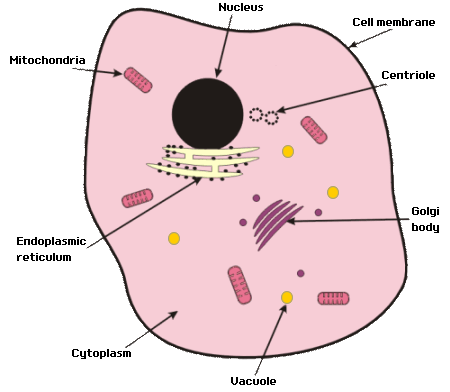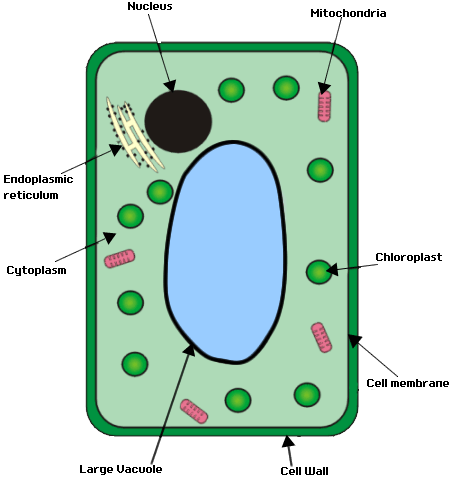CELLS & ORGANELLES
The cell is the fundamental unit that makes up living things. Some organisms such as Amoeba consist of just one cell that must carry out all the functions of living things by itself.
Many organisms like plants and animals are made up of many cells co-operating together to make one living thing. The functions of living things can be shared out to specific cells or groups of cells within the organism.
The cell is a very complex structure. It has many mini organs called organelles that have their own jobs.


- The Nucleus
- This is the control centre for the cell. It contains structures called Chromosomes made of a chemical called DNA. In the DNA is coded information that tells the cell how to make many different proteins. Proteins have many different functions. By controlling what proteins are made the nucleus can control what the cell looks like and what it does.
- Mitochondria
- These sausage shaped structures are the powerhouses of the cell. It is here where food is broken down in aerobic respiration which releases energy for use by the cell. The more active the cell the greater the number of mitochondria found.
- Chloroplasts
- These are only found in plant cells. They contain the green pigment, Chlorophyll, which absorbs light energy. This is then converted into chemical energy so that carbon dioxide and water can be converted into Glucose.
- Cytoplasm
- This watery gel contains many dissolved chemicals. Here many of the enzyme controlled chemical reactions take place. This is the general work place of the cell.
- Endoplasmic reticulum
- This is a series of membranes folded to form channels. Attached to the membranes are small bodies called ribosomes. It is in these membrane channels that proteins are made, organised by the ribosomes.
- Cell membrane
- This barrier keeps the cell contents together. It controls what enters and what leaves the cell. The membrane is said to be semi or more accurately selectively permeable. This means that some things can pass through the membrane but not others.
- Cell wall
- Found only in plant cells. Made of a carbohydrate called Cellulose. It is fully permeable. It provides a limiting structure of the cell and gives support for it.
- Cell vacuole
- These are membrane bound bubbles that are found in the cytoplasm. In animal cells the vacuoles are very small and numerous, filled with things like food molecules. Plant cells have one large vacuole, which is filled with cell sap, a watery sugar/salt mixture. In plants it helps to maintain turgor by aiding with osmosis.
- Centriole
- There are two of these in every animal cell (plant cells have similar structures). They help to organise cell division during Mitosis & Meiosis.
- Golgi Apparatus
- These stacks of membrane bound discs collect protein from the endoplasmic reticulum and package and modify it before it is used or excreted from the cell.
Plant and animal cells have some obvious differences. Animal cells lack cell walls, chloroplasts and large vacuoles. Animal cells also have rather irregular shapes compared with the regular shapes of plant cells.
